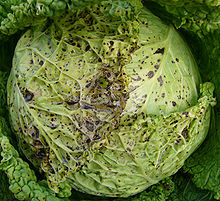| Turnip yellow mosaic virus | |
|---|---|
 | |
| Turnip yellow mosaic virus on cabbage, found in Bělidla, Olomouc, Moravia, Czech Republic | |
| Virus classification | |
| (unranked): | Virus |
| Realm: | Riboviria |
| Kingdom: | Orthornavirae |
| Phylum: | Kitrinoviricota |
| Class: | Alsuviricetes |
| Order: | Tymovirales |
| Family: | Tymoviridae |
| Genus: | Tymovirus |
| Species: | Tymovirus brassicae |
| Synonyms | |
| |

Turnip yellow mosaic virus (TYMV) is an isometric Tymovirus of the family Tymoviridae . Its host range is confined almost entirely to plants in the genus Brassica in western Europe, which includes cabbages, cauliflower and broccoli. [2] Infection causes bright yellow mosaic disease showing vein clearing and mottling of plant tissues.